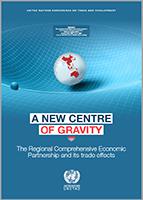
On 1 January 2022, the Regional Comprehensive Economic Partnership (RCEP) will enter into force. This free trade agreement includes 15 East Asian and Pacific Nations of different economic sizes and stages of development, representing around 30 per cent of world GDP. The RCEP will be the world’s largest trading bloc, in economic size, and is set to become a new centre of gravity for global trade.
The agreement encompasses several areas of cooperation, with tariff concessions a central principle, which will eliminate 90 per cent of tariffs within the bloc. The concessions are key in understanding the initial impacts of RCEP on trade, both inside and outside of the bloc. Intra RCEP-trade was already worth about US$ 2.3 trillion (2019) and this analysis shows that RCEP’s tariff concessions would further boost the intraregional exports of the newly formed alliance by nearly 2 per cent, approximately US$42 billion. This is the result of two forces: trade creation, as lower tariffs would stimulate trade between members, by nearly US$17 billion; and trade diversion, as lower tariffs within RCEP would redirect trade away from non-members to members, equivalent to nearly US$25 billion.
As in any other trade agreement, RCEP’s members are expected to gain to a varying extents from the agreement. Tariff concessions are expected to produce higher trade effects for the largest economies of the bloc, not because of negotiations asymmetries, but largely due to the already low tariffs between many of the other RCEP members. Indeed, the patterns of tariff concessions in RCEP show a degree of cooperation in the negotiation process.
This finding may have implications for potential new members because latecomers may find little left to negotiate, as the concessions of many of the existing RCEP members might already be shaped around the interests of the incumbents.
Overall, the tariff concessions of RCEP result in gains for the entire region. Most of these gains come from trade diverted away from non-members. As the process of integration of RCEP members goes further, these diversion effects could be magnified, a factor that should not be underestimated by non-RCEP members.


